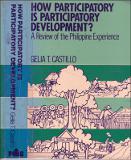| dc.description.abstract | About two-thirds of the Philippine population reside in the rural
areas, earning an average family income of only half of their urban
counterparts. It is, therefore, not surprising that much interest has
been expressed in the progress of rural development strategies,the
impact they have had on rural communities, the means by which
they can be made more effective, and the various alternatives that
exist.
This timely book by Gelia Castillo deals with a number of contemporary
and, to some extent, controversial issues regarding Philippine
rural development. More specifically, it looks into two important
aspects of rural development, namely: rural institutions and
people's participation. The former is about institutional changes in
the rural areas : changes in the way things are being done, as well as
changes in social organization and in the relationships among the
actors in that setting.Whether these changes are deliberately designed
and created, e.g., Samahang Nayon, Masagana99, compact farms,
etc., or result spontaneously from social, economic and political
changesthat take place over time, e.g., the relationships between
farmer and hired farm labor, and between landlord and tenant, they
nonetheless form part and parcel of the Philippine rural setting.
Thus, to fully understand rural development in the country, one
must appreciate these institutional changes.
The other aspect of rural development which Castillo examines
is that of people's participation. Who should participate? Who are
"the people"? Are they interested in participating? What constitutes
participation? Does participation make a difference? What experience
have we had in the practice of people's participation? These
are some of the questions that the author grapples with in her work.
The coverage alone, as well as the complexity of the issues involved,
suggests how courageous the author had been in venturing
into this study. Her work demanded that she personally sieve through
volumes upon volumes of research reports,,evaluative studies, surveys,
graduate theses, etc., organize their findings into an integrated, readable form, and derive insights from many otherwise apparently
innocent observations.
Through this book, the author has done for us a great service.
Not only do we now have access to the results of scattered studies on
important aspects of rural development in the country. We can also
appreciate them from the vantage point the author has taken, as well
as enjoy her fluid, thought-provoking and insightful style.
Gelia Castillo has, indeed, made another valuable contribution to
our better understanding of Philippine rural society. | en_GB |


